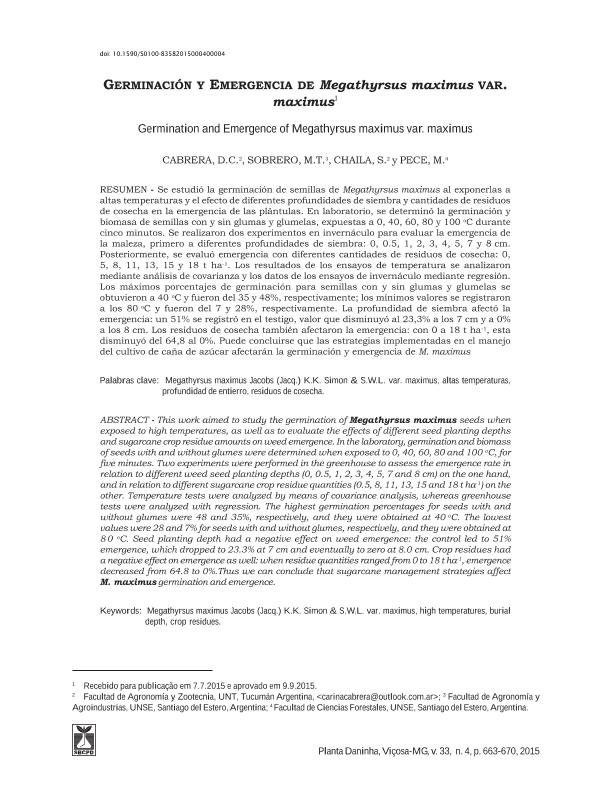Mostrar el registro sencillo del ítem
dc.contributor.author
Cabrera, Debora Carina

dc.contributor.author
Sobrero, M. T.
dc.contributor.author
Chaila, S.
dc.contributor.author
Pece, M.
dc.date.available
2017-02-10T21:45:04Z
dc.date.issued
2015-10
dc.identifier.citation
Cabrera, Debora Carina; Sobrero, M. T.; Chaila, S.; Pece, M.; Germinación y emergencia de Megathyrsus Maximus Var.Maximus; Universidade Federal Vicosa. Sociedade de Investigacoes Florestais; Planta Daninha; 33; 4; 10-2015; 663-670
dc.identifier.issn
0100-8358
dc.identifier.uri
http://hdl.handle.net/11336/12900
dc.description.abstract
Se estudió la germinación de semillas de Megathyrsus maximus al exponerlas a altas temperaturas y el efecto de diferentes profundidades de siembra y cantidades de residuos de cosecha en la emergencia de las plántulas. En laboratorio, se determinó la germinación y biomasa de semillas con y sin glumas y glumelas, expuestas a 0, 40, 60, 80 y 100 oC durante cinco minutos. Se realizaron dos experimentos en invernáculo para evaluar la emergencia de la maleza, primero a diferentes profundidades de siembra: 0, 0.5, 1, 2, 3, 4, 5, 7 y 8 cm. Posteriormente, se evaluó emergencia con diferentes cantidades de residuos de cosecha: 0, 5, 8, 11, 13, 15 y 18 t ha-1. Los resultados de los ensayos de temperatura se analizaron mediante análisis de covarianza y los datos de los ensayos de invernáculo mediante regresión. Los máximos porcentajes de germinación para semillas con y sin glumas y glumelas se obtuvieron a 40 oC y fueron del 35 y 48%, respectivamente; los mínimos valores se registraron a los 80 oC y fueron del 7 y 28%, respectivamente. La profundidad de siembra afectó la emergencia: un 51% se registró en el testigo, valor que disminuyó al 23,3% a los 7 cm y a 0% a los 8 cm. Los residuos de cosecha también afectaron la emergencia: con 0 a 18 t ha-1, esta disminuyó del 64,8 al 0%. Puede concluirse que las estrategias implementadas en el manejo del cultivo de caña de azúcar afectarán la germinación y emergencia de M. maximus.
dc.description.abstract
This work aimed to study the germination of Megathyrsus maximus seeds when exposed to high temperatures, as well as to evaluate the effects of different seed planting depths and sugarcane crop residue amounts on weed emergence. In the laboratory, germination and biomass of seeds with and without glumes were determined when exposed to 0, 40, 60, 80 and 100 oC, for five minutes. Two experiments were performed in the greenhouse to assess the emergence rate in relation to different weed seed planting depths (0, 0.5, 1, 2, 3, 4, 5, 7 and 8 cm) on the one hand, and in relation to different sugarcane crop residue quantities (0.5, 8, 11, 13, 15 and 18 t ha-1) on the other. Temperature tests were analyzed by means of covariance analysis, whereas greenhouse tests were analyzed with regression. The highest germination percentages for seeds with and without glumes were 48 and 35%, respectively, and they were obtained at 40 oC. The lowest values were 28 and 7% for seeds with and without glumes, respectively, and they were obtained at 80 oC. Seed planting depth had a negative effect on weed emergence: the control led to 51% emergence, which dropped to 23.3% at 7 cm and eventually to zero at 8.0 cm. Crop residues had a negative effect on emergence as well: when residue quantities ranged from 0 to 18 t ha-1, emergence decreased from 64.8 to 0%.Thus we can conclude that sugarcane management strategies affect M. maximus germination and emergence.
dc.format
application/pdf
dc.language.iso
spa
dc.publisher
Universidade Federal Vicosa. Sociedade de Investigacoes Florestais

dc.rights
info:eu-repo/semantics/openAccess
dc.rights.uri
https://creativecommons.org/licenses/by-nc-sa/2.5/ar/
dc.subject
Megathyrsus Maximus Jacobs (Jacq.) K.K. Simon & S.W.L. Var. Maximus
dc.subject
Altas Temperaturas
dc.subject
Profundidad de Entierro
dc.subject
Residuos de Cosecha
dc.subject.classification
Otras Ciencias Agrícolas

dc.subject.classification
Otras Ciencias Agrícolas

dc.subject.classification
CIENCIAS AGRÍCOLAS

dc.title
Germinación y emergencia de Megathyrsus Maximus Var.Maximus
dc.title
Germination and Emergence of Megathyrsus maximus var. maximus
dc.type
info:eu-repo/semantics/article
dc.type
info:ar-repo/semantics/artículo
dc.type
info:eu-repo/semantics/publishedVersion
dc.date.updated
2017-02-09T17:57:58Z
dc.identifier.eissn
1806-9681
dc.journal.volume
33
dc.journal.number
4
dc.journal.pagination
663-670
dc.journal.pais
Brasil

dc.journal.ciudad
Viçosa
dc.description.fil
Fil: Cabrera, Debora Carina. Universidad Nacional de Tucumán. Facultad de Agronomía y Zootecnia; Argentina. Consejo Nacional de Investigaciones Científicas y Técnicas; Argentina
dc.description.fil
Fil: Sobrero, M. T.. Universidad Nacional de Santiago del Estero. Facultad de Agronomia y Agroindustrias; Argentina
dc.description.fil
Fil: Chaila, S.. Universidad Nacional de Tucumán. Facultad de Agronomía y Zootecnia; Argentina
dc.description.fil
Fil: Pece, M.. Universidad Nacional de Santiago del Estero. Facultad de Ciencias Forestales; Argentina
dc.journal.title
Planta Daninha

dc.relation.alternativeid
info:eu-repo/semantics/altIdentifier/doi/http://dx.doi.org/10.1590/S0100-83582015000400004
dc.relation.alternativeid
info:eu-repo/semantics/altIdentifier/url/http://ref.scielo.org/w6gt3x
Archivos asociados
